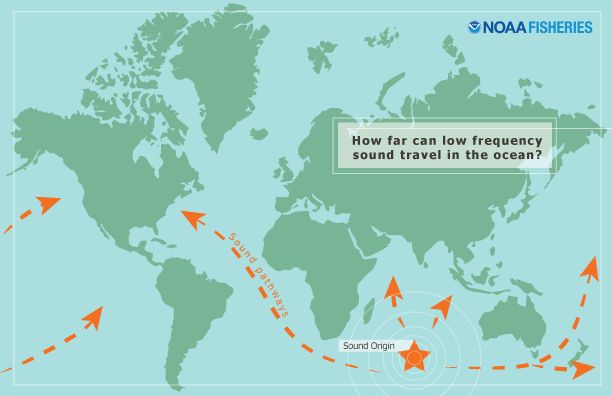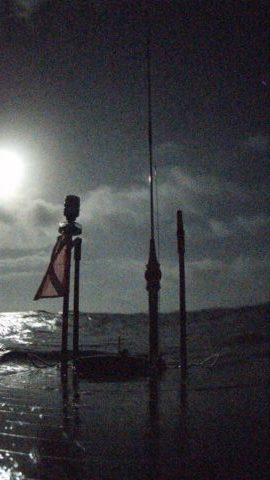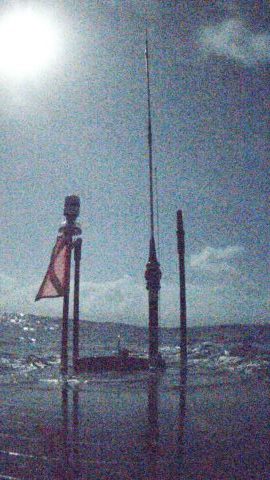Visibility in the ocean is relatively weak, especially at a depth of 400+ meters, making vision rather useless in the deep sea where whales reside. Sunlight doesn’t travel very far into the ocean. However, acoustic vibrations travel faster and farther in water than they do on land (Image 1). Therefore, sounds are valuable tools in deep, dark environments where whales use their ears as their eyes.
Image 1: An image by NOAA. A visual representation how far low-frequency sounds travel through the ocean.
Animals in marine environments rely on sound for basic survival needs. For example, baleen whales, which are the largest of marine mammals (including humpback, blue, fin, right, and gray whales, etc.) emit long, low-frequency sounds ranging from 7Hz to 22kHz that travel long distances across the ocean. Baleen whales also travel long distances making periodic migratory trips from their feeding grounds to their breeding grounds. Thus, scientists hypothesize that baleen whales use low-frequency sound in part to aid in navigation and long-distance communication.
The ocean is already a naturally loud environment, and humans have significantly increased that noise level. Anthropogenic noise pollution (such as ship traffic) obscures animals' communication, and could potentially have adverse effects on marine life; especially baleen whales (Image2). Although, considerable scientific uncertainty remains. Many factors influence the degree of impact, including multiple characteristics of the sound, and the animal. Potential impacts include behavior alternation, temporary hearing loss, and various communication interferences (Image 3).
Image 2: An image by the University of Rhode Island. A visual representation (in frequency (Hz)) of how anthropogenic noises interfere with marine mammals. Baleen whales' sounds are masked by seismic, ship traffic and bubbles & spray noises.
Image 3: An image by SSPA. A visual representation of anthropogenic noise interference with marine animals.
Scientists study sounds and their relationship with the environment over a wide range of scales (both spatial and temporal) via a new science called ecoacoustics. They investigate sounds to understand their evolution, functions, and properties under environmental stressors and changes. Sounds are used as tools to monitor ecological factors, such as biotic and abiotic relationships, and animal behavior, diversity, abundance, distribution, etc.
Using hydrophones to record marine acoustics have helped scientists gain knowledge, and a better understanding of the ocean and how we’re affecting it. We are proud to say our Wave Gliders (WGs) don’t produce noise that’s harmful to whales or other marine life. So far, we think WGs do not deter animals: fish aggregate around them, birds rest on them, whales swim near them, and dolphins bow ride them. The WG has revolutionized the way we collect data and monitor the ocean. The hydrophone we attached to Europa is gathering acoustic data 24/7 through which we hope to gain more knowledge and understanding of the sea. Additionally, we expect our data will create a baseline, and contribute to marine ecoacoustics, as well as, support conservation efforts and the management of marine resources.
Europa Update:
Europa is approaching our second seamount; we’re within 25 miles! Stay tuned for a seamount update, the ecology of seamounts, and the habitats they provide in our next blog.















